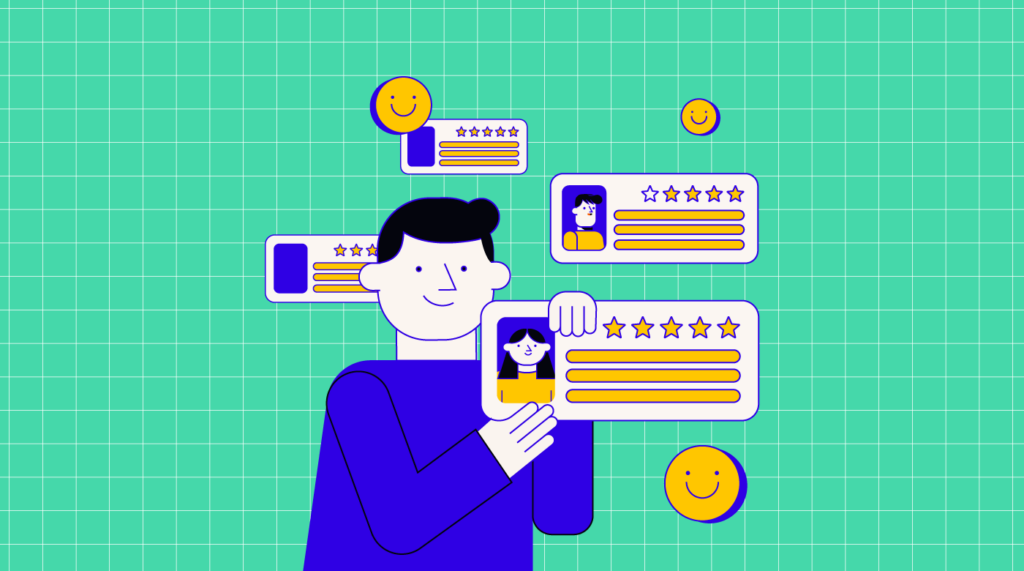The best way to keep improving and to stay on top of customer satisfaction is by constantly gathering customer feedback.
Through feedback you gain customer insight to find out what’s working and what isn’t in your customer experience strategy. Feedback is valuable to help you understand customer service painpoints and build better products and services, enticing your customer base to remain loyal and content.
It doesn’t matter whether your business is at the top of your industry or struggling to grow, understanding the customer experience is critical.
So, here's why client feedback is so important plus a few ways to help you gather customer feedback to get fresh insight, improve your products, and understand how potential customers perceive your brand.
Why Is Feedback Important?
Finding out what your customers think about your company and product is important. Asking for customer insight not only shows them that you value their responses but also that you want to improve your product and services using their positive and negative feedback. Client feedback tells you how you can appease an unhappy customer so you can build their trust and make them feel like their input on their customer journey really matters. This creates good customer relationships with your users, improving customer satisfaction and bringing repeat business. There is no downside to constructive customer feedback.
6 Clever Ways To Get Customer Feedback
Asking your customers what they think about your products and services is a big help when assessing how to improve your business and achieve customer success. Customers may have insights that you may not have thought of, good and bad and so it expands your knowledge base. Different types of feedback from existing customers can help direct business development and change any negative feedback into positive. By using the right feedback management tools and following the steps below, you can get the essential insights your team needs.

1. Take Pre And Post-Purchase Surveys To Evaluate Every Part Of The Process
Please don’t just use some boring customer feedback survey that your users have to trudge through. You want people to enjoy giving some honest feedback and not to find it tedious. Have the feedback form pop up right after their purchase to evaluate their experience navigating the website or send an email after delivery of goods or services to get direct feedback about what you’re selling.
You can use Google Forms, Jotform, or Typeform, which all allow you to design your feedback form and survey questions with a theme you choose. You can even add videos and tweak the feedback tool so that it is engaging and traces your customer's journey. For more honest feedback, offer surveys to your customers soon after they interact with your brand so the experience is still fresh in their minds.
A great tool for doing this, and incentivizing users to participate in giving feedback is a company called Starloop - their platform gives users the feel-good benefit of planting a tree for every review they submit on Facebook or Google.
For more options, check out our pick of the best online survey software or the best enterprise survey software on the market today. Or, if your budget is limited, a free poll maker would also do the trick.
Related read: How To Ask Customers To Fill Out A Survey
2. Set Up Instagram Story Polls To See Who Is Engaging And What They Think
Companies cannot ignore social media and their followers when they are looking for actionable customer feedback. While not scientific, Instagram polls are a way to test the waters around your business and the general customer sentiment as well as get an idea of how engaging your Instagram content is.
Interactive poll stickers let you ask every type of feedback question you can think of and see results from people who see your story, actionable insight and a chance for customer interaction. Any social media marketing needs to integrate with those who are monitoring customer experiences so they get the necessary data from Instagram followers to use it to improve their future experiences.
3. Use Facebook Polls To Engage With Followers Regularly
Facebook offers another way for your customers to leave feedback. Using Facebook polls expands your company’s influence and gains attention that makes your brand noticeable and increases engagement with those who like your page or who are searching for a product like yours. Polls help you see where to focus your online posts and direct in-house business management.
Again, you have to work with those on the social media team to put it all together but it’s a great way to get ideas from your Facebook page.
4. Listen To Social Media Posts Beyond Polling To See What Customers Are Really Saying
You can use polls on social media to gather specific information but you can learn even more from people post about your brand because they are pleased or upset with your product or service. People understand the power of social media and do their best to use it to make their voices heard.
Watch for hashtags and brand mentions, of course, but you can also use a social media listening tool to make sure you don’t miss anything. This is a good way to address issues quickly but also to make business changes as needed. Customer service people should be heavily involved in crafting responses quickly, especially if the feedback is negative which could affect investor relations.
5. Chatbots Can Interact Effectively And Save Time
If you want immediate feedback, chatbots are one way to get it. They can be set to collect various information and meet certain objectives so you can get the information you need to help figure out what works and what doesn’t. Chatbots are engaging and do a good enough job as a contact center. They’re better than a survey for certain applications and offer more of a human touch to the customer experience. It’s great conversational marketing for customer-based improvement.
IT staff will have to get it up and running and the staff has to monitor the interactions but it’s a good way to engage with your customers as they land on your site.
6. Use A Messenger Survey To Directly Collect Feedback From People Who Like And Follow Your Company
To move beyond simple social media interactions with your customers, use Messenger. People generally enjoy this type of interaction. Facebook is huge and has millions of users.
Messenger allows you to easily interact with customers and collect their reviews and feedback easily. Companies such as SurveyMonkey create surveys that show up in messaging apps and look like direct messages incorporating light conversation that results in customer feedback.
Final Thoughts
However, you choose to get customer feedback, make sure you get the information you need to help your business grow and make customer experiences better. There are a lot of things to collect!
Put interactions with your customers at the forefront, ask for direct input, and be creative when you do it. No one is going to take time to answer a survey if they find it boring. Provide an incentive for customers to give their opinion and thank them so they feel appreciated and like their input is valued.
In other words, make customer feedback a priority when you want to make sure their experience is top-notch.
Get More CX Insight
You can get further support and insight reading The CX Lead Newsletter which helps you build the customer feedback tools you need and to find out what worked and what didn’t for others in the industry.
Related Read: Optimizing The Website Customer Journey
Related Lists of Tools:
- Customer Success Software For CX Teams
- Customer Review Management Software
- Customer Onboarding Software To Help Users Enter Your Ecosystem Smoothly
- The Importance Of Customer Interviews And How To Conduct Them
- Best A/B Testing Tools for Data-Driven Experiments
- Best Polling Software
- Best Customer Intelligence Platforms


